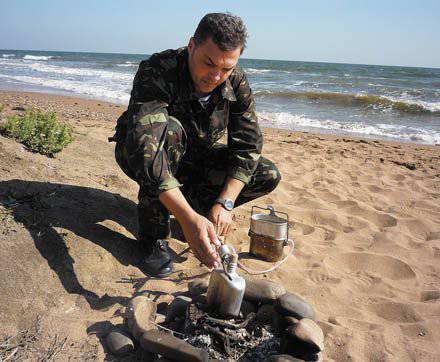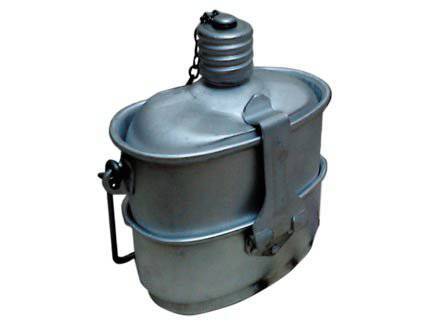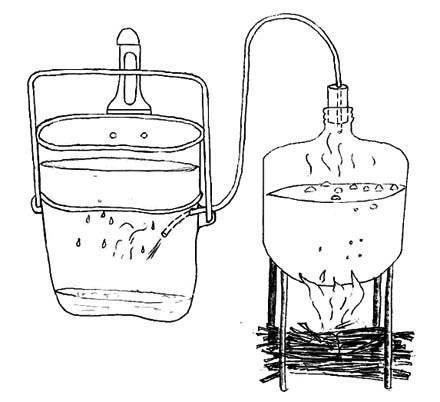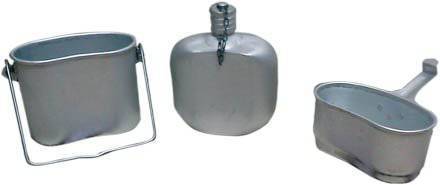Kettle: instructions for use
 To maintain human life, only three components are needed: air, water and food. And if we can’t touch and get the first one, then the availability of the rest depends solely on our ingenuity, and in a critical situation and on the availability of the necessary equipment, such as a combined kettle with a flask. A thing known, but very few people know about its multifunctional capabilities.
To maintain human life, only three components are needed: air, water and food. And if we can’t touch and get the first one, then the availability of the rest depends solely on our ingenuity, and in a critical situation and on the availability of the necessary equipment, such as a combined kettle with a flask. A thing known, but very few people know about its multifunctional capabilities.It would seem that you can still think up, looking at the combined pot with a flask, in addition to carrying water and cooking? After all, it was for these purposes that it was conceived and made. But do not rush to make unambiguous conclusions. Everything is not so simple, and this quite universal thing can become indispensable in the field, combat and conditions of autonomous survival.
The combined 1989 sample flask of the year is the most sophisticated of the versatile flasks on the market. You can use the kit for its intended purpose, and for many other functions. Multifunctionality along with some modifications can be used in the most unexpected situations.
Немного stories. The combined bowler with a flask was adopted by the Airborne Forces by order of the USSR Minister of Defense No. 78 of 17.09.1959 of the Year “On the Adoption of an Aluminum Combined Bowler with a flask for the Airborne Forces”. The manufacturer is the Leningrad factory "Red Vyborzhets", as evidenced by the stamp "KV".
It served as a prototype for the army bowler, which was made at the same factory since 1931, and was in service with the Red Army before World War II. In turn, the army bowler outwardly resembled the bowler of the Kaiser's army of the 1910 model of the year, which was accepted for equipment instead of the kettle of the 1893 model of the year. The capacity of the German pot is 1,7 liters, on the pot itself there are two small horizontal lines that mark every 0,5 liters of volume. A wire handle was attached to the pot.
Approximately until 1943, the pot was stamped from aluminum, and then began the production of cheaper steel kettles. It was during this period that a metal buckle was fastened to the steel handle on the lid of the pot, through which a black leather strap passed, fixing the lid on the pot. Leather strap was a standard sample, the same as that used for attaching the roll length 52 cm, with a buttoned buttonhole loop. Outside, the pot was covered in dark gray paint, and since April 1941, it has been painted in olive green.
However, the new model has significant differences, and this is the merit of Soviet developers. They perfected it so much that so far it has not lost its relevance and is not inferior to the best examples of foreign armies in universality. And ease of manufacture, along with cheapness, rightfully takes such a “comber” to the top.
 The purpose of adopting a combination bowler with a flask is obvious - reducing the amount of fighter's wearable property. This is directly related to the tasks assigned to the Airborne Forces, as the paratrooper has to act in the rear of the enemy, apart from his own supply bases, and it is inconvenient to carry with him a huge field soldier's bowler hat.
The purpose of adopting a combination bowler with a flask is obvious - reducing the amount of fighter's wearable property. This is directly related to the tasks assigned to the Airborne Forces, as the paratrooper has to act in the rear of the enemy, apart from his own supply bases, and it is inconvenient to carry with him a huge field soldier's bowler hat.The first samples of a combined pot with a flask were made of two parts, and the flask was with a rolled flannel to cover the boiler part. This option later entered the provision of civil defense units of the Soviet Union.
The next model, adopted in the 1989 year, is in service with the units and subunits of the Airborne Forces of Russia up to the present. To him was added podkotelnik. Accordingly, the need for a flask rim has disappeared. In later versions of the kit, the flask was made of plastic.
Army kettles were worn in different ways: inside the backpacks (in a special pocket), on the “rusk” valve (usually on the left, next to the flask), on the combat backpack, on the waist belt of the belt or even on the belt. Inside the pot, soldiers usually stored bread, lunch rations or other products. Known case when carrying binoculars in the pot. Ways to wear a set has not changed, and its functionality will be relevant for many years. Initially, at the exit, the kit, which the soldiers affectionately dubbed the “matryoshka”, was placed on a belt in a case; as the ammunition was consumed, it was shifted to the taxiway. If it is supposed to overcome obstacles during movement, it should be stored only in the taxiway.
This kit has proven itself in all armed conflicts in which Russia had to participate. In addition, he enjoys success with hunters, tourists and fishermen.
The set of the combined pot with a flask includes:
aluminum flask (plastic) with attached lid;
kettle with a handle;
podkotelnik with a handle.
In this configuration, the flask is inserted into the pot, the pot - into the caliper, and the entire kit is inserted into the cover, which is supplied separately and is intended for storing and transporting the product.
Kit size assembled: 182 x 160 x 90 mm.
Kit color: light aluminum. All elements are made of light food aluminum according to army specifications.
Due to storage storage, the factory storage kit is in solid oil. Therefore, it is first recommended to disassemble all the components of the combined pot with a flask and boil them separately in soda solution. After that, allow to cool to room temperature and wipe dry. It is better to rinse the inside of the flask with boiling water or alcohol. After that the flask will be ready for operation.
Before using the flask, it is recommended to grind it with an emery paper, this will give the necessary clearance, which does not allow it to jam in the field conditions when sand gets inside. They should enter each other more than freely.
The cover is a rather important element of the kit, not only because it allows the kettle to be fastened to the belt, but also because it does not allow the contents of the backpack to be soiled about soot, which quickly enough pollutes the surface of the set.
Each individual item in the kit has a different purpose.
Separately flask can be used:
for carrying liquids in volumes up to 1 liters;
as a kettle for boiling (aluminum), after unscrewing the twist;
capacity for distillation of urine, dirty or sea water;
as an anchor for throwing a safety rope on a tree, when getting into a swamp swamp, moving on a swimming facility or hovering a rope crossing.
The main pot can be used:
for cooking both in suspended, and in land situation;
for carrying liquids in volumes up to 1 liters over long distances (complete with a curler);
for carrying water from the place of its intake to the place of cooking;
as a steam catcher for distilling (complete with a rake);
as a water collector in a solar distiller (desalination plant);
as a container for collecting, carrying, storing berries and other loose food products;
as a container for technical needs in the manufacture of soap, tar, glue and other components;
as a tank for kindling snow (ice) and getting drinking water.
Podkotelnik can perform the functions of:
bowls for cooking or laying out main dishes;
mugs for making drinks;
scoop for intake of water or processing of friable soil (sand);
pans for kindling fat and cooking;
lids of the main pot when carrying water, cooking or distilling the liquid in it.
The cover can be used:
to carry the kit and protect it from dirt;
for carrying various items (shop, cartridges, nuts, berries, etc.);
when wet, as a thermostat to keep the fluid in cool condition;
for making patches from it when repairing clothes and equipment.
Variants of use of this product are diverse, and along with minor modifications can turn it into a serious and indispensable element of equipment.
It is most practical to cook food in two containers at the same time. In this case, the bristle is installed on top of the pot, bottom-down, in the form of a lid and secured with a handle from the pot, the guides of which at the top point should go into special grooves on the bogie. The handle of the popcorn in this case is fed under the handle of the pot and is thus fixed. In the future, this combination will be referred to as "design." In this position, the structure is mounted on the supports of the “migun” campfire, the stand of the hearth, or suspended directly above the fire. In the lower pot the first (second) dish can be cooked, and in the upper pot - the second (third) dish.
I also introduced and experimentally tested two more unique functionalities of the kettle combined with the flask.
With minor modifications, such a structure can now be used as a distiller (desalinator) of our own urine, polluted or sea water. To do this, a hole is drilled into the side of the pot between the edge and the ear of the handle, into which any flexible hose of a suitable diameter of length 0,5 – 1 meter is inserted. The windshield washer hose of the car, the main hose of the blood transfusion system, etc. may come up. A typical PET bottle cap with a hole of the same diameter as the pot in which the second end of the hose is inserted or the wine bottle stopper is placed on the flask with a through hole in the middle. The second option is preferable, since it provides better tightness and is less heat resistant, keeping part of the hose from melting. The plug can also be made in field conditions from tree bark or other suitable material. Podkotelnik installed on the pot in the form of a lid and fixed. The resulting structure is lowered into a cold place (earth, water), and cold water is poured into the bed strawberry for better condensation of steam. A flask filled with no more than 2 / 3 from its volume with a liquid is placed on coal or suspended by a chain from a cover over a small fire.
 The process of vapor formation and condensation under ideal conditions begins already in 7 – 8 minutes. In the process of vapor extraction, such a structure is able to distill (desalinate) any liquid in any quantity. For an hour, it can overtake more than 400 grams of urine, polluted or sea water, which is quite enough to maintain the body's water balance in an extreme situation.
The process of vapor formation and condensation under ideal conditions begins already in 7 – 8 minutes. In the process of vapor extraction, such a structure is able to distill (desalinate) any liquid in any quantity. For an hour, it can overtake more than 400 grams of urine, polluted or sea water, which is quite enough to maintain the body's water balance in an extreme situation.In the process of distillation, it is necessary regularly, as soon as the first bubbles appear, to update the liquid cooling in the popodyle. With a good sealing of the pipe joints, the loss of evaporated liquid will not exceed 100 ml of the 700 contained in the flask. Accordingly, it is necessary to pour the new liquid into the flask for distillation after 70 – 90 minutes of boiling, depending on the intensity of the fire. After boiling the liquid, it is best to move it onto the coals to prevent a lot of pressure, and hence the loss of liquid in the form of steam.
In the cool period, the hose can be immediately lowered into the pot without making holes in it and not covering it with a pinch pin. In this case, the steam has time to cool and condense, getting into the pot in the form of purified and ready-to-use water.
The second invention is the use of the structure as an additional tank for carrying water over long distances. Beforehand, it is necessary to make a gasket according to the size of the kettle from a piece of the wheel chamber or an old gas mask and place it between the kettle and the lid (tiller) or use cellophane to make it leakproof. In this case, the volume of water transferred is doubled - 1 liter in a flask nested in the rake, and 1 liter in the pot. In this case, some of the inconvenience of carrying will be compensated by a large supply of liquid.
Advantages:
the set is universal, multi-functional, convenient and compact when carried;
with minimal capacity, it allows to warm up or cook in field conditions several types of hot food per person (kettle - the first dish, second drinker, second aluminum flask - broth, drink or tea);
the design allows you to cook food equally comfortably on a fire, on alcohol and gas burners, as well as on various taganka tiles;
the production uses a rather thick aluminum sheet, hence the increased strength and durability of the product. Thicker material also ensures an even distribution of heat and reduces the risk of food sticking;
the main capacity of the pot and flask has a rational volume for use by one person;
the small diameter of the neck dispenses the flow of water while saving it and does not allow it to flow out quickly in case of accidental tipping. If the cover is lost, it is easier to make a plug from the materials at hand. On the other hand, it is inconvenient to wash the flask inside, it is difficult to draw water from shallow open sources;
thanks to the metal case of the flask and its flat bottom, after unscrewing the cap, it is possible to boil water in it, which does not allow making samples from plastic or oval flasks. Such a flask can also be hung above the fire by a chain from the lid;
relatively cheap and affordable product.
Disadvantages:
Black sealing rubber was used in the cork, which, after prolonged use, gives an unpleasant smell to the water carried in the flask. Corrected by replacing the cork seal;
accidental loss stopper insurance is made in the form of a steel chain, which is used to knock on the flask in motion when the flask is located on the belt. Corrected by the use of gum or replacement of rope insurance;
if the flask is not full, it can click very loudly at the wrong moment, cooling down and shrinking from the cold. It is corrected with the help of cellophane, newspaper, stretched gum or rope;
Some inconvenience is caused by the need to put a popcorn on the pot from the bottom - after cooking on the fire, if there is no possibility to properly wash the pot, you have to put the popcotler on the inside with a dirty smoked pot. On the other hand, the soot is covered with a clean container, which prevents the case from getting dirty;
bowler is difficult to wash off the eaten soot, especially if it is from the resinous tree species. Corrected by thorough cleaning with sand or earth;
the design is very difficult to disassemble, if during transport in the folded state sand or dirt gets into the jar and pot. Corrected using plastic bags or plastic flasks;
in some off-spec products, the folding handle of the pot is made poorly (longer than normal; due to incorrect crimping, the loops cannot make a full turn through the top, only from the bottom). Corrects with the help of the tool, changing the direction of the docking handle to the pot on the opposite;
pot instability. It is corrected by thoughtful installation of the pot on the coals, taking into account the possible burning of the latter or by hanging the pot over the fire;
The handle of the popcote is very hot when it is heated on a bonfire or burner. Corrected with a rag or stick tied to the handle.
The weight of the product with this versatility and reliability is optimal. In some cases, it can be adjusted by removing the case, the binder and using a plastic jar, which is somewhat lighter than aluminum. This will save about 260 grams, but will deprive it of some functionality.
 In addition, the use of a plastic flask has both advantages and disadvantages. Positive is the alleviation of the weight of the kit, the reduction of its cost, the possibility of free removal of the flask from the pot if sand is ingested or deformed the pot, control of the water level, and better lid tightness. At the same time, the major drawbacks are the impossibility of boiling or heating water directly in the jar and the strength of the material.
In addition, the use of a plastic flask has both advantages and disadvantages. Positive is the alleviation of the weight of the kit, the reduction of its cost, the possibility of free removal of the flask from the pot if sand is ingested or deformed the pot, control of the water level, and better lid tightness. At the same time, the major drawbacks are the impossibility of boiling or heating water directly in the jar and the strength of the material.In general, a combined pot with a flask in operation is very convenient and practical. In addition to the above disadvantages, which are eliminable in all cases, there are no particular complaints during operation. As can be seen, the use of this type of flask is extremely effective not only in army units and special forces units, but also in emergency kits (NAZ) for flight and sea crews.
To improve this product, we can offer an increase in the volume of a plastic flask to a liter 1,5 due to its elongation and an increase in the neck width. Alternatively, you can blow PET flasks of desired shape and quality with a standard or enlarged neck. Such flasks will have less weight, price and are easy to replace in the event of contamination or failure.
Information